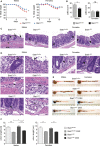STAT1 is a sex-specific tumor suppressor in colitis-associated colorectal cancer
- PMID: 29419930
- PMCID: PMC5891040
- DOI: 10.1002/1878-0261.12178
STAT1 is a sex-specific tumor suppressor in colitis-associated colorectal cancer
Abstract
The interferon-inducible transcription factor STAT1 is a tumor suppressor in various malignancies. We investigated sex-specific STAT1 functions in colitis and colitis-associated colorectal cancer (CRC) using mice with specific STAT1 deletion in intestinal epithelial cells (STAT1∆IEC ). Male but not female STAT1∆IEC mice were more resistant to DSS-induced colitis than sex-matched STAT1flox/flox controls and displayed reduced intraepithelial infiltration of CD8+ TCRαβ+ granzyme B+ T cells. Moreover, DSS treatment failed to induce expression of T-cell-attracting chemokines in intestinal epithelial cells of male but not of female STAT1∆IEC mice. Application of the AOM-DSS protocol for induction of colitis-associated CRC resulted in increased intestinal tumor load in male but not in female STAT1∆IEC mice. A sex-specific stratification of human CRC patients corroborated the data obtained in mice and revealed that reduced tumor cell-intrinsic nuclear STAT1 protein expression is a poor prognostic factor in men but not in women. These data demonstrate that epithelial STAT1 is a male-specific tumor suppressor in CRC of mice and humans.
Keywords: CD8+ T cells; STAT1; colitis; colorectal cancer; gender; sex.
© 2018 The Authors. Published by FEBS Press and John Wiley & Sons Ltd.
Figures





References
-
- Angell H and Galon J (2013) From the immune contexture to the Immunoscore: the role of prognostic and predictive immune markers in cancer. Curr Opin Immunol 25, 261–267. - PubMed
-
- Bollrath J, Phesse TJ, von Burstin VA, Putoczki T, Bennecke M, Bateman T, Nebelsiek T, Lundgren‐May T, Canli O, Schwitalla S et al (2009) gp130‐mediated Stat3 activation in enterocytes regulates cell survival and cell‐cycle progression during colitis‐associated tumorigenesis. Cancer Cell 15, 91–102. - PubMed
Publication types
MeSH terms
Substances
Grants and funding
LinkOut - more resources
Full Text Sources
Other Literature Sources
Medical
Molecular Biology Databases
Research Materials
Miscellaneous

